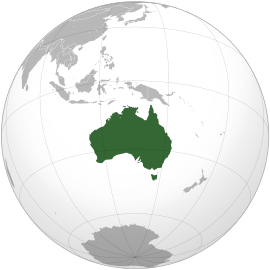Commonwealth of Australia
 |
 |
| Flag | Coat of arms |
Anthem: "Advance Australia Fair"[N 1]
| Capital | Canberra 35°18.48′S 149°7.47′E |
|
| Largest city | Sydney | |
|---|---|---|
| Official language(s) | None[N 2] | |
| National language | English (de facto)[N 2] | |
| Demonym | Australian, Aussie[3][4] | |
| Government | Federal parliamentary constitutional monarchy | |
| - | Monarch | Elizabeth II |
| - | Governor-General | Quentin Bryce |
| - | Prime Minister | Julia Gillard |
| Legislature | Parliament | |
| - | Upper house | Senate |
| - | Lower house | House of Representatives |
| Independence | from the United Kingdom | |
| - | Constitution | 1 January 1901 |
| - | Statute of Westminster | 11 December 1931 |
| - | Statute of Westminster Adoption Act | 9 October 1942 (with effect from 3 September 1939) |
| - | Australia Act | 3 March 1986 |
| Area | ||
| - | Total | 7,617,930 km2 (6th) 2,941,299 sq mi |
| Population | ||
| - | 2012 estimate | 22,932,091[5] (52nd) |
| - | 2006 census | 19,855,288[6] |
| - | Density | 2.8/km2 (233rd) 7.3/sq mi |
| GDP (PPP) | 2011 estimate | |
| - | Total | $914.482 billion[7] (18th) |
| - | Per capita | $40,234[7] (12th) |
| GDP (nominal) | 2011 estimate | |
| - | Total | $1.488 trillion[7] (13th) |
| - | Per capita | $65,477[7] (5th) |
| Gini (2006) | 30.5[8] (medium) | |
| HDI (2011) | ||
| Currency | Australian dollar (AUD) |
|
| Time zone | various[N 3] (UTC+8 to +10.5) | |
| - | Summer (DST) | various[N 3] (UTC+8 to +11.5) |
| Date formats | dd-mm-yyyy | |
| Drives on the | left | |
| ISO 3166 code | AU | |
| Internet TLD | .au | |
| Calling code | +61 | |
Australia, officially the Commonwealth of Australia,[10] is a country in the Southern Hemisphere comprising the mainland of the Australian continent as well as the island of Tasmania and numerous smaller islands in the Indian and Pacific Oceans.[N 4] It is the world's sixth-largest country by total area. Neighbouring countries include Indonesia, East Timor and Papua New Guinea to the north; the Solomon Islands, Vanuatu and New Caledonia to the north-east; and New Zealand to the south-east.
For at least 40,000 years[12] before European settlement in the late 18th century, Australia was inhabited by indigenous Australians,[13] who belonged to one or more of roughly 250 language groups.[14][15] After discovery by Dutch explorers in 1606, Australia's eastern half was claimed by Great Britain in 1770 and settled through penal transportation to the colony of New South Wales from 26 January 1788. The population grew steadily in subsequent decades; the continent was explored and an additional five self-governing Crown Colonies were established.
On 1 January 1901, the six colonies federated, forming the Commonwealth of Australia. Since Federation, Australia has maintained a stable liberal democratic political system which functions as a federal parliamentary democracy and constitutional monarchy. The federation comprises six states and several territories. The population of 22.9 million is heavily concentrated in the Eastern states and is highly urbanised.
A highly developed country, Australia is the world's 13th-largest economy and has the world's fifth-highest per capita income. Australia's military expenditure is the world's 13th-largest. With the second-highest human development index globally, Australia ranks highly in many international comparisons of national performance, such as quality of life, health, education, economic freedom, and the protection of civil liberties and political rights.[16] Australia is a member of the G20, OECD, WTO, APEC, UN, Commonwealth of Nations, ANZUS, and the Pacific Islands Forum.















0 comments:
Post a Comment